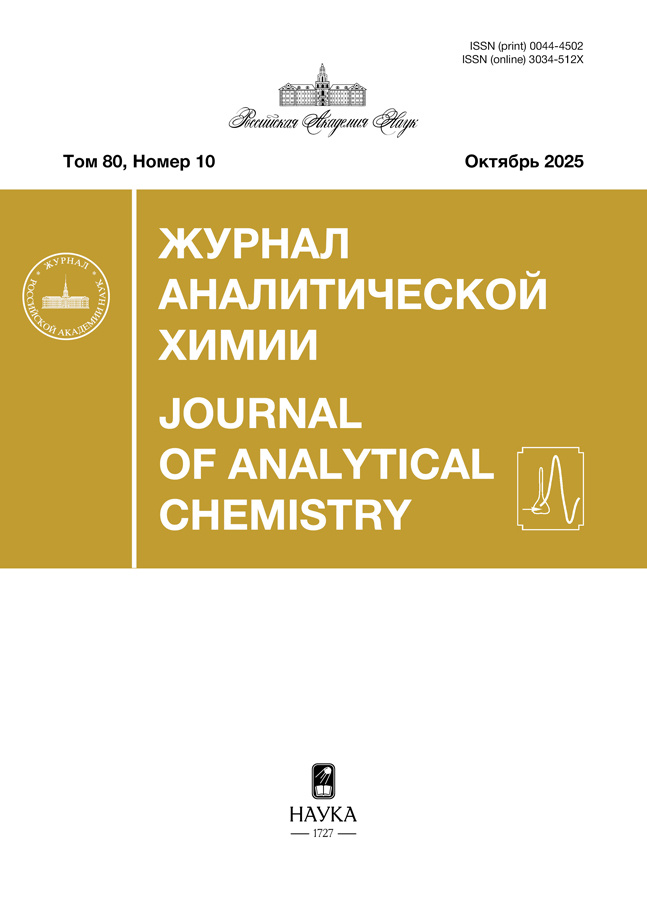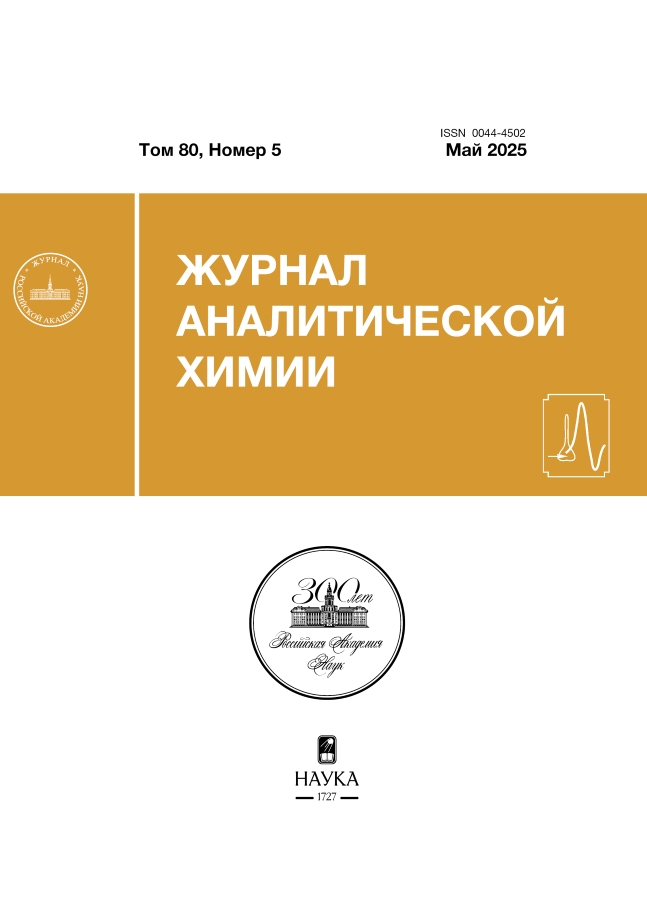Разработка алгоритма обработки данных “электронного носа” на пьезосенорах при анализе проб крови без пробоподготовки: пилотное исследование
- Авторы: Кучменко Т.А.1,2, Менжулина Д.А.3
-
Учреждения:
- Институт геохимии и аналитической химии имени В.И. Вернадского Российской академии наук
- Воронежский государственный университет инженерных технологий
- Воронежский государственный медицинский университет имени Н.Н. Бурденко
- Выпуск: Том 80, № 5 (2025)
- Страницы: 501-517
- Раздел: ОРИГИНАЛЬНЫЕ СТАТЬИ
- Статья получена: 20.06.2025
- Статья одобрена: 20.06.2025
- URL: https://ruspoj.com/0044-4502/article/view/685445
- DOI: https://doi.org/10.31857/S0044450225050066
- EDN: https://elibrary.ru/atlafr
- ID: 685445
Цитировать
Полный текст
Аннотация
Представлены первые результаты анализа крови пациентов отделений разного профиля без пробоподготовки с применением портативного “электронного носа” на пьезосенсорах. В течение полугода на базе клинической лаборатории областной больницы параллельно проводились анализы крови пациентов традиционными методами и сенсорным. Рассмотрено влияние условий (температура помещения, кратность повтора, природа модификаторов электродов пьезосенсоров) на повторяемость сигналов массива сенсоров. Предложены эффективные подходы и алгоритмы обработки многомерных данных массива пьезосенсоров при детектировании профиля летучих соединений (ЛОС) крови малого объема (не более 0.5 мл). В качестве внутреннего стандарта при анализе проб крови без пробоподготовки в условиях лаборатории эффективно применение проб дистиллированной воды второго типа. Проанализированы образцы проб крови от 250 пациентов. Установлено, что набором пьезосенсоров надежно выделяются пробы при ярко выраженных патологиях воспаления, онкологии, серьезных проблемах в работе почек, высочайшем уровне стресса (операция; ДТП с травмами, несовместимыми с жизнью; ожоги). Другие патологии также фиксируются с помощью предложенного параметра, но его величина зависит от индивидуального состояния пациента, наличия сопутствующих заболеваний, достижения компенсации, степени выраженности негативных процессов при поступлении (например, сахарный диабет второго типа). Отличие профилей ЛОС для проб с разными значимыми патологиями с покомпонентным анализом – предмет следующего сообщения. Оптимизирован способ детектирования летучих соединений крови (режим измерения, кратность повтора) и предложены простые эффективные алгоритмы обработки массива данных сенсоров.
Ключевые слова
Полный текст
Об авторах
Т. А. Кучменко
Институт геохимии и аналитической химии имени В.И. ВернадскогоРоссийской академии наук; Воронежский государственный университет инженерных технологий
Автор, ответственный за переписку.
Email: tak1907@mail.ru
Россия, Москва; Воронеж
Д. А. Менжулина
Воронежский государственный медицинский университет имени Н.Н. Бурденко
Email: tak1907@mail.ru
Россия, Воронеж
Список литературы
- Teränen V., Nissinen S., Roine A., Antila A., Siiki A., Vaalavuo Y., Kumpulainen P., Oksala N., Laukkarinen J. Bile-volatile organic compounds in the diagnostics of pancreatic cancer and biliary obstruction: A prospective proof-of-concept study // Front. Oncol. 2022. V. 12. № 918539. https://doi.org/10.3389/fonc.2022.918539
- Navaneethan U., Parsi M.A., Gutierrez N.G., Bhatt A., Venkatesh P.G., Lourdusamy D., Grove D., Hammel J.P., Jang S., Sanaka M.R., Stevens T., Vargo J.J., Dweik R.A. Volatile organic compounds in bile can diagnose malignant biliary strictures in the setting of pancreatic cancer: A preliminary observation // Gastrointest. Endosc. 2014. V. 8. Iss. 6. P. 1038. https://doi.org/10.1016/j.gie.2014.04.016
- Nissinen S.I., Roine A., Hokkinen L., Karjalainen M., Venäläinen M., Helminen H., Niemi R., Lehtimäki T., Rantanen T., Oksala N. Detection of pancreatic cancer by urine volatile organic compound analysis // Anticancer Res. 2019. V. 39. № 1. P. 73. https://doi.org/10.21873/anticanres.13081; PMID: 30591442
- Esfahani S., Wicaksono A., Mozdiak E., Arasaradnam R.P., Covington J.A. Non-invasive diagnosis of diabetes by volatile organic compounds in urine using FAIMS and Fox4000 electronic nose // Biosensors (Basel). 2018. V. 8. № 4. P. 121. https://doi.org/10.3390/bios8040121; PMID: 30513787; PMCID: PMC6316010
- Weng X., Li G., Liu Z., Liu R., Liu Z., Wang S., Zhao S., Ma X., Chang Z. A preliminary screening system for diabetes based on in-car electronic nose // Endocr. Connect. 2023. V. 12. № 3. e220437. https://doi.org/10.1530/EC-22-0437; PMID: 36662684; PMCID: PMC9986382
- Khokhar M. Non-invasive detection of renal disease biomarkers through breath analysis // J. Breath Res. 2024. V. 18. Article 024001. https://doi.org/10.1088/1752-7163/ad15fb
- Gaye O., Fall C.B., Jalloh M., Faye B., Jobin M., Cussenot O. Detection of urological cancers by the signature of organic volatile compounds in urine, from dogs to electronic noses // Curr. Opin. Urol. 2023. V. 33. № 6. P. 437. https://doi.org/10.1097/MOU.0000000000001128; PMID: 37678152
- Afonso H.A.S., Farraia M.V., Vieira M.A., Cavaleiro Rufo J. Diagnosis of pathological conditions through electronic nose analysis of urine samples: A systematic review and meta-analysis // Porto Biomed. J. 2022. V. 7. № 6. e188. https://doi.org/10.1097/j.pbj.0000000000000188; PMID: 37152083; PMCID: PMC10158878
- Pelling M., Chandrapalan S., West E., Arasaradnam R.P. A systematic review and meta-analysis: Volatile organic compound analysis in the detection of hepatobiliary and pancreatic cancers // Cancers (Basel). 2023. V. 15. № 8. P. 2308. https://doi.org/10.3390/cancers15082308; PMID: 37190235; PMCID: PMC10136496
- Laird S., Debenham L., Chandla D., Chan C., Daulton E., Taylor J., Bhat P., Berry L., Munthali P., Covington J.A. Breath analysis of COVID-19 patients in a tertiary UK hospital by optical spectrometry: The E-Nose CoVal study // Biosensors (Basel). 2023. V. 13. № 2. P. 165. https://doi.org/10.3390/bios13020165; PMID: 36831932; PMCID: PMC9953365
- Wintjens A.G.W.E., Hintzen K.F.H., Engelen S.M.E., Lubbers T., Savelkoul P.H.M., Wesseling G., van der Palen J.A.M., Bouvy N.D. Applying the electronic nose for pre-operative SARS-CoV-2 screening // Surg. Endosc. 2021. V. 35. № 12. P. 6671. https://doi.org/10.1007/s00464-020-08169-0; PMID: 33269428; PMCID: PMC7709806
- Wilson A.D., Forse L.B. Potential for early noninvasive COVID-19 detection using electronic-nose technologies and disease-specific VOC metabolic biomarkers // Sensors (Basel). 2023. V. 23. № 6. P. 2887. https://doi.org/10.3390/s23062887; PMID: 36991597; PMCID: PMC10054641
- Wilson A.D. Application of electronic-nose technologies and VOC-biomarkers for the noninvasive early diagnosis of gastrointestinal diseases // Sensors (Basel). 2018. V. 18. № 8. P. 2613. https://doi.org/10.3390/s18082613; PMID: 30096939; PMCID: PMC6111575
- De Meij T.G., Larbi I.B., van der Schee M.P., Lentferink Y.E., Paff T., sive Droste J.S.T., Mulder C.J., van Bodegraven A.A., de Boer N.K. Electronic nose can discriminate colorectal carcinoma and advanced adenomas by fecal volatile biomarker analysis: Proof of principle study // Int. J. Cancer. 2014. V. 134. № 5. P. 1132. https://doi.org/10.1002/ijc.28446
- de Kroon R.R., Frerichs N.M., Struys E.A., de Boer N.K., de Meij T.G.J., Niemarkt H.J. The potential of fecal volatile organic compound analysis for the early diagnosis of late-onset sepsis in preterm infants: A narrative review // Sensors (Basel). 2024. V. 24. № 10. P. 3162. https://doi.org/10.3390/s24103162; PMID: 38794014; PMCID: PMC11124895
- Arasaradnam R.P., Covington J.A., Harmston C., Nwokolo C.U. Review article: Next generation diagnostic modalities in gastroenterology--gas phase volatile compound biomarker detection // Aliment. Pharmacol. Ther. 2014. V. 39. № 8. P. 780. https://doi.org/10.1111/apt.12657; Epub Feb 20, 2014. PMID: 24612215
- Hosfield B.D., Pecoraro A.R., Baxter N.T., Hawkins T.B., Markel T.A. The assessment of fecal volatile organic compounds in healthy infants: Electronic nose device predicts patient demographics and microbial enterotype // J. Surg. Res. 2020. V. 254. P. 340. https://doi.org/10.1016/j.jss.2020.05.010; PMID: 32526503; PMCID: PMC7483828
- Wei C., Pan Y., Zhang W., He Q., Chen Z., Zhang Y. Comprehensive analysis between volatile organic compound (VOC) exposure and female sex hormones: A cross-sectional study from NHANES 2013-2016 // Environ. Sci. Pollut. Res. Int. 2023. V. 30. № 42. P. 95828. doi: 10.1007/s11356-023-29125-0; PMID: 37561291
- ГОСТР 52501-2005. Национальный стандарт РФ. Вода для лабораторного анализа. Технические условия. М.: Стандартинформ, 2008. 16 с.
- Кучменко Т.А., Умарханов Р.У., Менжулина Д.А. Биогидроксиапатит – новая фаза для селективного микровзвешивания паров органических соединений – маркеров воспаления в носовой слизи телят и человека. Сообщение 1. Сорбция в модельных системах // Сорбционные и хроматографические процессы. 2021. Т. 21. № 2. С. 142.
- Kuchmenko Т.А. Electronic nose based on nanoweights, expectation and reality // Pure Appl. Chem. 2017. V. 89. № 10. P. 1587. https://doi.org/10.1515/pac-2016-1108
- Kuchmenko T.A., Lvova L.B. A perspective on recent advances in piezoelectric chemical sensors for environmental monitoring and foodstuffs analysis // Chemosensors. 2019. V. 7. № 3. P. 39. https://doi.org/10.3390/chemosensors7030039
- Kuchmenko T.A., Lvova L.B. Piezelectric chemosensors and multisensory systems / Chemoresponsive Materials: Smart Materials for Chemical and Biological Stimulation. 2nd Ed. / Ed. Schneider H., The Royal Society of Chemistry, 2022, Ch. 16. P. 567. https://pubs.rsc.org/en/content/ebook/978-1-83916-277-0
- Кучменко Т.А. Химические сенсоры на основе пьезокварцевых микровесов / Проблемы аналитической химии. Т. 14 / Под ред. Власова Ю.Г. М.: Наука, 2011. С. 127.
Дополнительные файлы






























